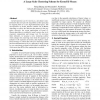Free Online Productivity Tools
i2Speak
i2Symbol
i2OCR
iTex2Img
iWeb2Print
iWeb2Shot
i2Type
iPdf2Split
iPdf2Merge
i2Bopomofo
i2Arabic
i2Style
i2Image
i2PDF
iLatex2Rtf
Sci2ools
ICPR
2002
IEEE
2002
IEEE
A Large Scale Clustering Scheme for Kernel K-Means
Kernel functions can be viewed as a non-linear transformation that increases the separability of the input data by mapping them to a new high dimensional space. The incorporation of kernel function enables the K-Means algorithm to explore the inherent data pattern in the new space. However, the recent applications of kernel KMeans algorithm are confined to small corpora due to its expensive computation and storage cost. To overcome these obstacles, we propose a new clustering scheme which changes the clustering order from the sequence of samples to the sequence of kernels, and employs a diskbased strategy to control data. The new clustering scheme has been demonstrated to be very efficient for large corpus by our experiments on hand-written digits recognition, in which more than 90% of the running time was saved.
| Added | 14 Jul 2010 |
| Updated | 14 Jul 2010 |
| Type | Conference |
| Year | 2002 |
| Where | ICPR |
| Authors | Rong Zhang, Alexander I. Rudnicky |
Comments (0)

